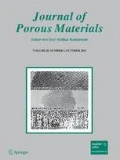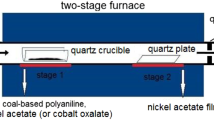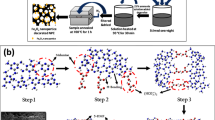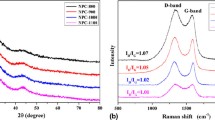Abstract
N-doped porous carbon (NPC)/iron oxide (FexOy) composites with rich nanoscale meso–macropores and high specific capacitances are successfully synthesized through a facile single-step pyrolysis approach, using coal-based polyaniline prepared through an in-situ polymerization method as a carbon and nitrogen source, and ferric citrate aqueous solution as a catalyst precursor. In NPC/FexOy, porous carbon mainly presents in the amorphous state. Nitrogen is successfully doped into NPC in the form of graphitic N, pyrrolic N, and pyridinic N. FexOy sphere particles with the diameter of 50–500 nm are embedded in the pores or on the surface of porous carbon. The NPC yield is about 65.4% and the nitrogen content is 0.122 wt%. The BET specific surface area and average pore width are 224.6 m2/g and 3.8 nm, respectively. NPC/FexOy composites demonstrate a high specific capacitance of 449 F/g at a current density of 1 A/g, good cycling stability, high capacitance retention of 88.2% at 5.0 A/g after 5000 cycles of charge and discharge, and good rate capability. Compared with NPC/FexOy from the pyrolysis of coal or polyaniline, NPC/FexOy from coal-based polyaniline possesses much better capacitance properties for owning a large number of evenly distributed and nanoscale meso–macropores greatly contributed by some interpenetrating network structures of coal-based polyaniline. This study will provide a facile and promising approach for the value-added applications of low-rank coal.






Similar content being viewed by others
Change history
12 October 2017
The original version of this article unfortunately contained the below equations in “Capacitance properties of NPC/FexOy composites” section which was not described, but was displayed in the article. The author wants to remove these equations.
References
D. Pech, M. Brunet, H.G. Durou, P.H. Huang, V. Mochalin, Y. Gogotsi et al., Ultrahigh-power micrometre-sized supercapacitors based on onion-like carbon. Nat. Nanotechnol. 5, 651–654 (2010)
J. Yan, Q. Wang, T. Wei, Z.J. Fan, Recent advances in design and fabrication of electrochemical supercapacitors with high energy densities. Adv. Energy Mater. 4, 157–164 (2014)
X. Zhang, Y. Jiao, L. Sun et al., GO-induced assembly of gelatin toward stacked layer-like porous carbon for advanced supercapacitors. Nanoscale 8, 2418–2427 (2016)
H.G. Wang, Y.H. Wang, Y.H. Li, Y.C. Wan, Q. Duan, Exceptional electrochemical performance of nitrogen-doped porous carbon for lithium storage. Carbon 82, 116–123 (2015)
F. Sun, J. Gao, Y. Yang, Y. Zhu, L. Wang, X. Pi, X. Liu, Z. Qu, S. Wu, Y. Qin, One-step ammonia activation of Zhundong coal generating nitrogen doped microporous carbon for gas adsorption and energy storage. Carbon 109, 747–754 (2016)
N.P. Wickramaratne, J.T. Xu, M. Wang, L. Zhu, L.M. Dai, M. Jaroniec, Nitrogen enriched porous carbon spheres: attractive materials for supercapacitor electrodes and CO2 adsorption. Chem. Mater 26, 2820–2828 (2014)
L. Sun, C. Tian, Y. Fu, Y. Yang, J. Yin, L. Wang et al., Nitrogen-doped porous graphitic carbon as an excellent electrode material for advanced supercapacitors. Chem. Eur. J. 20, 564–574 (2014)
L. Sun, L. Wang, C. Tian et al., Nitrogen-doped graphene with high nitrogen level via a one-step hydrothermal reaction of graphene oxide with urea for superior capacitive energy storage. RSC Adv. 2, 4498–4506 (2012)
D. Hulicova-Jurcakova, M. Kodama, S. Shiraishi, H. Hatori, Z.H. Zhu, G.Q. Lu, Nitrogen-enriched nonporous carbon electrodes with extraordinary supercapacitance. Adv. Funct. Mater. 19, 1800–1809 (2009)
M.J. Iglesias, J.C. Rio, F. Laggoun-Defarge, M.J. Cuesta, I. Suarez-Ruiz, Control of the chemical structure of perhydrous coals; FTIR and Py-GC/MS investigation. J. Anal. Appl. Pyrolysis 62, 1–34 (2002)
T.-G. Wang, B.R.T. Simoneit, Organic geochemistry and coal petrology of Tertiary brown coal in the Zhoujing mine, Baise Basin, South China: 3. Characteristics of polycyclic aromatic hydrocarbons. Fuel 70, 819–829 (1991)
C. Achten, T. Hofmann, Native polycyclic aromatic hydrocarbons (PAH) in coals—a hardly recognized source of environmental contamination. Sci. Total Environ. 407, 2461–2473 (2009)
J. Feng, X. Xue, X. Li et al., Products analysis of Shendong long-flame coal hydropyrolysis with iron-based catalysts. Fuel Process. Technol. 130, 96–100 (2015)
F. Zhang, D. Xu, Y. Wang et al., CO2 gasification of Powder River Basin coal catalyzed by a cost-effective and environmentally friendly iron catalyst. Appl. Energy 145, 295–305 (2015)
S.A. Dastgheib, J. Ren, M. Rostam-Abadi et al., Preparation of functionalized and metal-impregnated activated carbon by a single-step activation method. Appl. Surf. Sci. 290, 92–101 (2014)
X. Qi, X. Guo, L. Xue et al., Effect of iron on Shenfu coal char structure and its influence on gasification reactivity. J. Anal. Appl. Pyrolysis 110, 401–407 (2014)
K-C. Xie, Structure and Reactivity of Coal. (Springer, Berlin, 2015), pp. 38–39 305–329
K. Fu, Q. Yue, B. Gao, Y. Sun, Y. Wang, Q. Li et al., Physicochemical and adsorptive properties of activated carbons from arundo donax linn utilizing different iron salts as activating agents. J. Taiwan Inst. Chem. Eng. 45, 3007–3015 (2014)
L.B. Hoch, E.J. Mack, B.W. Hydutsky, J.M. Hershman, J.M. Skluzacek, T.E. Mallouk, Carbothermal synthesis of carbon-supported nanoscale zero-valent iron particles for the remediation of hexavalent chromium. Environ. Sci. Technol. 42, 2600–2605 (2008)
X. Zhu, F. Qian, Y. Liu et al., Controllable synthesis of magnetic carbon composites with high porosity and strong acid resistance from hydrochar for efficient removal of organic pollutants: an overlooked influence. Carbon 99, 338–347 (2016)
H. Wang, W. Wang, M. Gui et al., Uniform Fe3O4/nitrogen-doped mesoporous carbon spheres derived from ferric citrate-bonded melamine resin as an efficient synergistic catalyst for oxygen reduction. ACS Appl. Mater. Interfaces 9, 335–344 (2017)
Q. Wang, L. Jiao et al., Fe3O4 nanoparticles grown on graphene as advanced electrode materials for supercapacitors. J. Power Sources 245, 101–106 (2014)
X. Du, C. Wang, M. Chen et al., Electrochemical performances of nanoparticle Fe3O4/activated carbon supercapacitor using KOH electrolyte solution. J. Phys. Chem. C 113, 2643–2646 (2009)
W. Shi, J. Zhu, D.H. Sim et al., Achieving high specific charge capacitances in Fe3O4/reduced graphene oxide nanocomposites. J. Mater. Chem. 21, 3422–3427 (2011)
J. Wang, H. Wu, D. Gao, S. Miao, G. Wang, X. Bao, High-density iron nanoparticles encapsulated within nitrogen-doped carbon nanoshell as efficient oxygen electrocatalyst for zinc-air battery. Nano Energy 13, 387–396 (2015)
K.S.W. Sing, D.H. Everett, R.A.W. Haul, L. Moscou, R.A. Pieroti, J. Rouquerol, T. Siemieniewska, Reporting physisorption data for gas solid systems with special reference to the determination of surface-area and porosity (recommendations 1984). Pure Appl. Chem. 57, 603–619 (1985)
T. Matthias, K. Katsumi, N. Alexander et al., Physisorption of gases, with special reference to the evaluation of surface area and pore size distribution (IUPAC Technical Report). Pure Appl. Chem. 87, 1051–1069 (2015)
P.R. Solomon, M.A. Semo, E.M. Sutmergt, Coal pyrolysis: experiments, kinetic rates and mechanisms. Prog. Energy Combust. Sci. 18, 133–220 (1992)
M. Sevilla, A.B. Fuertes, Direct synthesis of highly porous interconnected carbon nanosheets and their application as high-performance supercapacitors. ACS Nano 8, 5069–5078 (2014)
H. Deng, Q. Li, J. Liu, F. Wang, Active sites for oxygen reduction reaction on nitrogen-doped carbon nanotubes derived from polyaniline. Carbon 112, 219–229 (2017)
W. Ding, Z. Wei, S. Chen et al., Space-confinement-induced synthesis of pyridinic- and pyrrolic nitrogen-doped graphene for the catalysis of oxygen reduction. Angew. Chem. Int. Ed. 52, 11755–11759 (2013)
H. Peng, Z. Mo, S. Liao et al., High performance Fe- and N-doped carbon catalyst with graphene structure for oxygen reduction. Sci. Rep. 3, 1765 (2013)
K.K. Lee, S. Deng, H.M. Fan, et al., α-Fe2O3 nanotubes-reduced graphene oxide composites as synergistic electrochemical capacitor materials. Nanoscale, 4, 2958–2961 (2012)
T. Cottineau, M. Toupin, T. Delahaye, et al., Nanostructured transition metal oxides for aqueous hybrid electrochemical supercapacitors. Appl. Phys. A 82, 599–606 (2006)
R. Bendi, V. Kumar, V. Bhavanasi et al., Metal Organic framework-derived metal phosphates as electrode materials for supercapacitors. Adv. Energy Mater. 6, 1501833 (2016)
G. Cai, X. Wang, M. Cui et al., Electrochromo-supercapacitor based on direct growth of NiO nanoparticles. Nano Energy 12, 258–267 (2015)
Acknowledgements
The authors thank for the financial support by the National Natural Science Foundation of China (21406176) and China Scholarship Council Foundation ([2015]5103).
Author information
Authors and Affiliations
Corresponding authors
Rights and permissions
About this article
Cite this article
Wang, X., Yang, Y., Zhang, Y. et al. Facile synthesis and capacitance properties of N-doped porous carbon/iron oxide composites through the single-step pyrolysis of coal-based polyaniline. J Porous Mater 25, 845–853 (2018). https://doi.org/10.1007/s10934-017-0497-8
Published:
Issue Date:
DOI: https://doi.org/10.1007/s10934-017-0497-8




